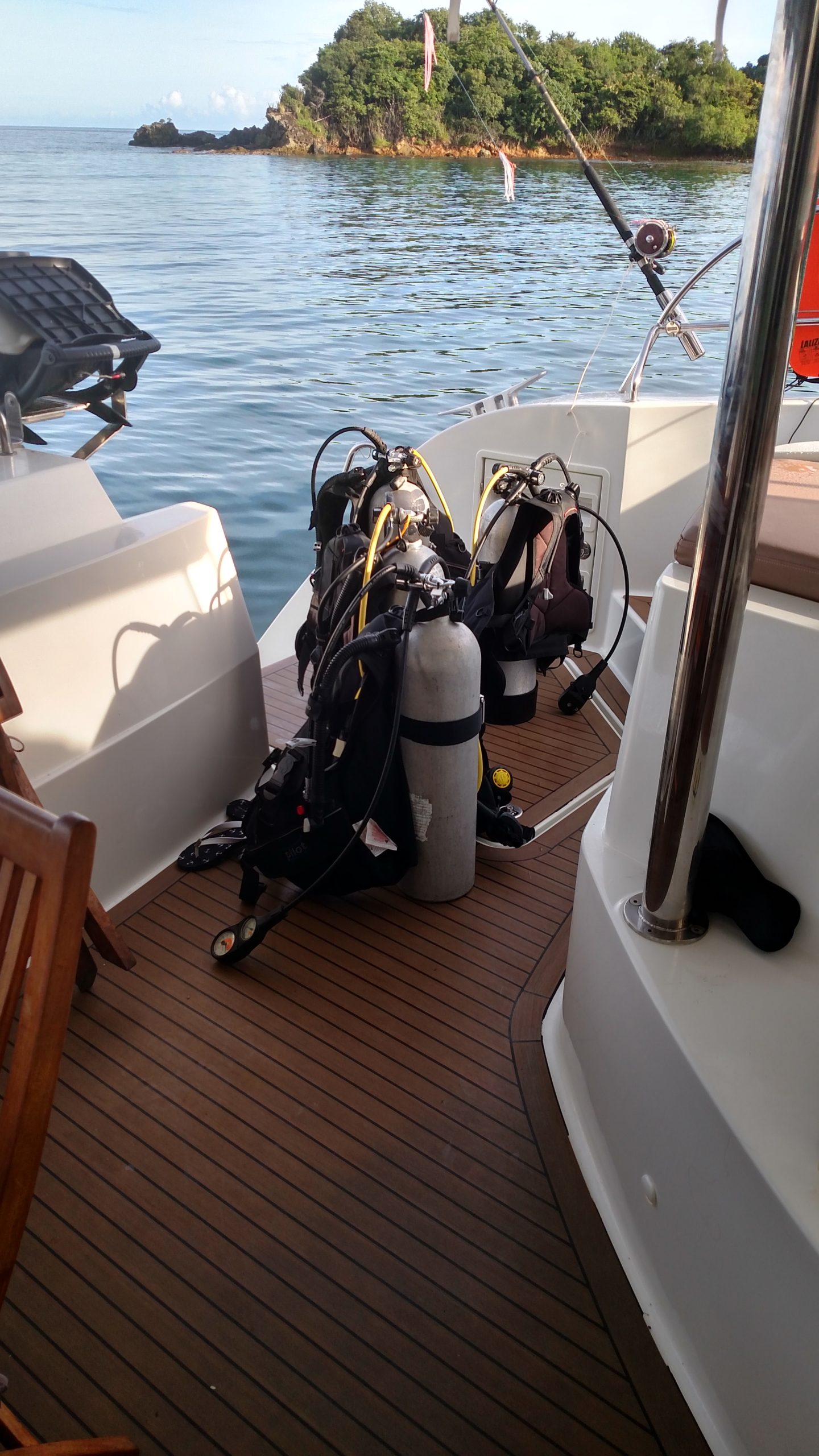Painting a scuba tank is very easy, in this simple step by step article I show you how you can easily and inexpensively paint a scuba tank.
I own several scuba tanks that I purchased used from people I know that didn’t use them much, or at all. I bought them for a fraction of what I would have paid for a new one. Through the years I bought them as a good deal became available. Aluminum 80’s are always around if you are looking for a good deal.

Like purchasing anything used, you need to do your due diligence and be reasonably confident in what you are buying. All of my used tanks have only had one or two hydrostatic tests done to them.
Hydrostatic testing is actually a damaging test, there are only so many hydrostatic tests a tank will pass. Eventually it will fail, but that is dependent on how many fills the cylinder has had and how much use it’s had.
My tanks have all had a pretty easy life compared to charter boat tanks.
To be clear, if my tanks were not painted at all, I would probably leave them that way. I think that’s the best way to purchase a tank. There is no way for salt water to get in behind the paint and corrode. That’s not a huge issue, but I have seen it happen.
All of my tanks were different colors, I am buying a boat and all of these tanks will eventually wind up on the boat. So I wanted to paint them all white so they would absorb the least amount of sunlight possible. A dark colored tank gets pretty hot and I wanted to avoid that. You can see this one is black. Black absorbs a lot of heat in the tropics.
When I worked at Club Med as a Scuba Instructor one of my many jobs was to paint tanks and touch them up as they became dinged and scratched through normal daily wear. People want to paint tanks for a variety of reasons, scuba tanks do get dinged up pretty often, it’s the nature of moving them around, getting them filled being around dive weights, etc. Scuba tanks live a pretty rough life.
Now it had been a while since I had painted a scuba tank, and to be honest I couldn’t quite remember what our procedure was so I did a search on the web and didn’t find much.
Important note: the information contained in this post only applies to aluminum cylinders, I have done absolutely no research on painting steel cylinders.
The main thing you do NOT want to do is to alter the structure of the aluminum alloy. There are several ways you can do this, by putting chemicals on the cylinder, by heating it, and by sanding. Any of these methods are potentially damaging to the cylinder and should not be attempted.
Manufacturer Recommendations
According to Luxfer, one of the main manufacturers of scuba tanks in the US there are acceptable ways to strip and prep the tank for painting.
If you are wanting to remove all of the existing paint from your cylinder, the best way according to Luxfer is to have it bead blasted with glass, plastic or another soft media. Do not use sand, steel, grit, aluminum oxide or any other hard media. Also do not use any chemical paint strippers to remove paint.

Now Catalina, another cylinder manufacturer gives completely different advice on their website. Catalina says you can use paint strippers that are compatible with aluminum.
Both Luxfer and Catalina manufacture their cylinders from 6061-T6 aluminum alloy, so shouldn’t they be the same, and shouldn’t the recommendations be the same? You would think so.
So what is going on? Well, Catalina says you must use paint strippers that are compatible with aluminum. Probably using something in the aircraft market might work, but I personally am not going to use a paint stripper on an aluminum scuba cylinder.
What are you to do?
Well if I was going to DIY completely stripping a scuba cylinder I would call the manufacturer of your cylinder and ask them specifically if you can use paint strippers, and if so what brand and type do they recommend.
For me it’s not worth it since I’m only concerned about changing the color. I don’t really care how great the finish is. I want it to look nice, but it doesn’t need to be polished to an automotive finish.
Preparation
This is the most important part of the process, and the most time consuming.

I didn’t particularly care about removing the paint from my existing tanks, I’m all about functionality, so I really just wanted them to look decent, but change the color to white for the functionality of not absorbing the light as well as having them all be the same color.
To scuff up the tank I used a green scotch brite pad and went over and over the surface of the tank. First I did this with the valve on. You don’t want to get anything in the tank. As you can see from the photo, there is a little shelf where the large 0-ring sits between the valve and the tank. You want to mask off this area.
You can see the manufacturer decal on the cylinder, I scraped this off with a metal scraper, a putty knife would have probably worked best, but I found the scraper first. The original paint on the cylinder was extremely hard, I scraped it pretty aggressively and didn’t wind up scraping it off.
Obviously you need to scrape all of the decals off. Then you need to get rid of the adhesive residue with a solvent. I used mineral spirits, but acetone would work well.
At this point if your existing paint is glossy I think it would be fine to scuff up the existing paint with some 220 grit sandpaper. Do not sand raw aluminum.
I didn’t scuff up the paint, this tank was pretty scuffed up anyway, so I felt comfortable with it.
Wash the tank with soap and water. The best way to clean it prior to priming or painting is to wash it several times with soap and water. I did wipe the entire tank with mineral spirits as a final degreaser.
Finally I removed the tank valve, you do this with a large wrench. Be very careful not to get anything in the tank. I then masked off the area where the o-ring sits.
Priming
I used a coat of primer on my tanks prior to painting. If you’re going to go through the process of painting, cleaning the tank, prepping your area, removing the valve, masking the opening, etc. then you might as well prime the existing paint for maximum adhesion of the paint. Primer is not very expensive and it will significantly increase the chances of the paint job working properly.
If you are painting raw aluminum you definitely need to use a self-etching primer. This is the one I used.

Painting
I used an automotive epoxy paint. I think there are many types of suitable paint, but I went with the automotive epoxy spray on paint. So far I have had good results with it and it should be easy to touch up if I ever need to.
Pro Tip: When you are painting or priming use a sweeping motion 8-10 inches away from the tank. Paint the tank lightly, wait about 10 minutes, then paint a little more. If you put a bunch of primer or paint on at once you risk the paint running and ruining your finish. Go slow.
Another type of paint I considered was a two-part marine paint. You would probably have to brush this type on, but it would be extremely durable. I went with the spray can paint for ease of use.
Not that most people have any type of oven large enough for baking a tank, but do not bake the paint on the tank. By heating the cylinder you will alter the aluminum alloy and potentially render it unsafe for use. Leaving it out in hot sunshine is fine.
It is ideal to paint a scuba cylinder prior to hydrostatic testing. That way any dive shop going to fill the tank will know it has been pressure tested. The new markings for the hydrostatic test will be punched into the tank on the tank shoulder and this will be visible to the technician filling your tank.
They may want to do a visual inspection on the inside of the cylinder, which should be conducted annually anyway, this is normal.
You may want to consult with your local dive shop prior to painting your cylinder. Some dive shops are finnicky about this sort of thing and won’t fill a painted cylinder.
To be clear there isn’t any type of requirement from Luxfer or any certifying body as far as I know of, and I’ve managed a dive center and worked professionally in the industry for many years. However, a dive operator can refuse to fill a tank if he or she wants. That’s why it is best to do this before hydrostatic testing, that way a dive center is less likely to refuse you service.
Pro Tip: Paint when you have ample time for the paint to cure, epoxy paints can take up to 30 days to completely cure. It should be cured enough to handle in a day though.

If this post has scared you off painting your cylinder know there are other alternatives such as tank wraps, or having your cylinder professionally painted. These are certainly going to be more expensive, but they will also likely give you better results as well.
My total cost was $10 for the primer and paint. I could probably do another tank as well. So not very expensive.

